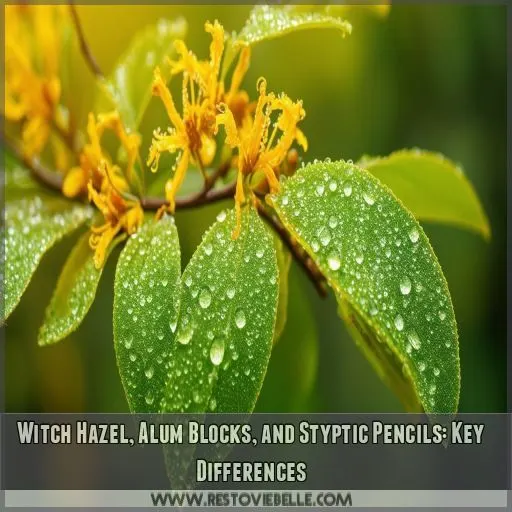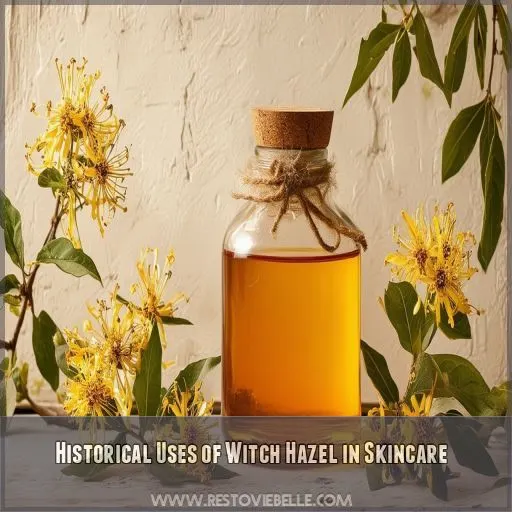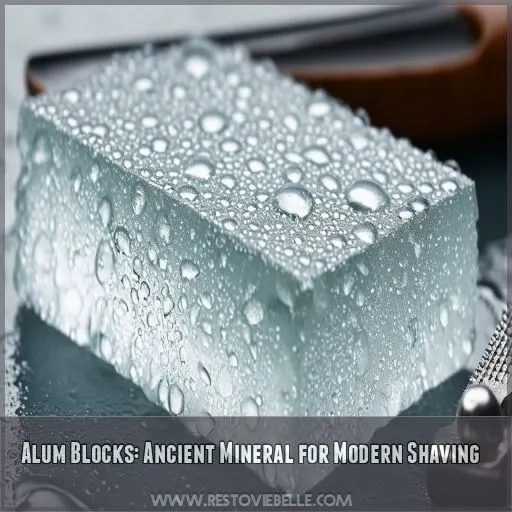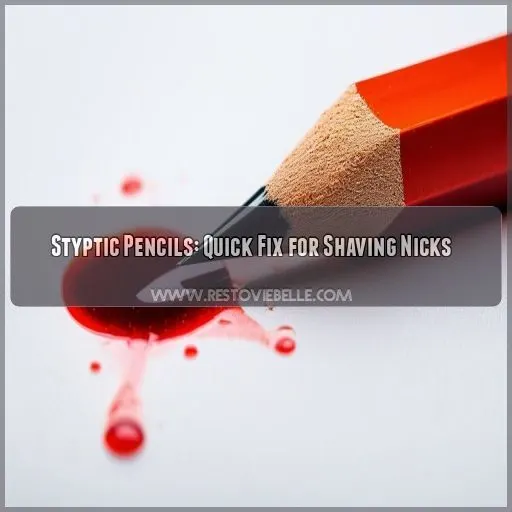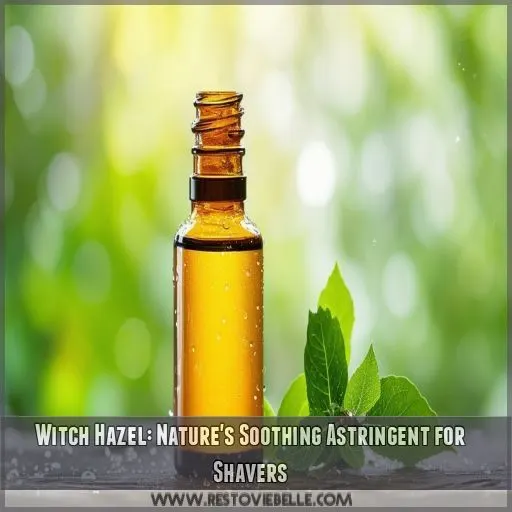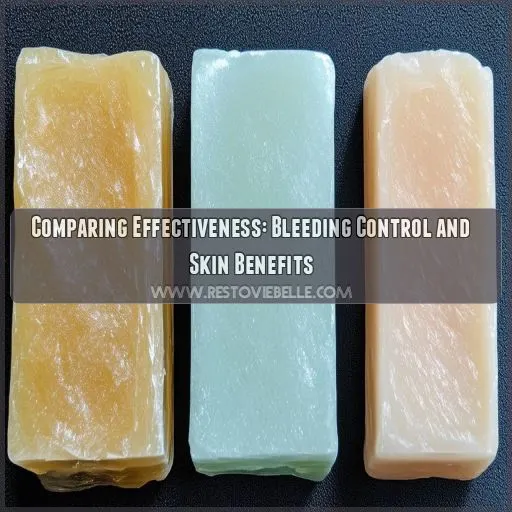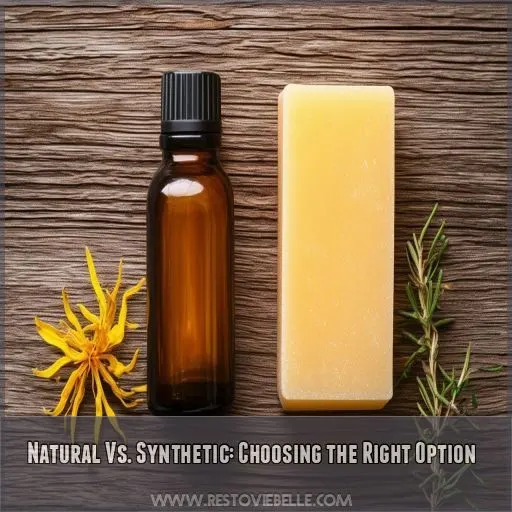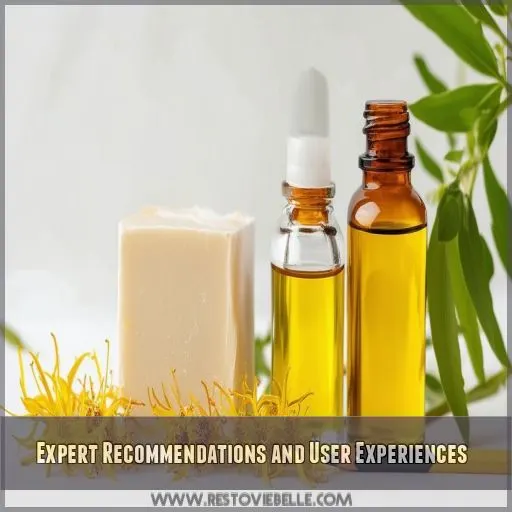This site is supported by our readers. We may earn a commission, at no cost to you, if you purchase through links.
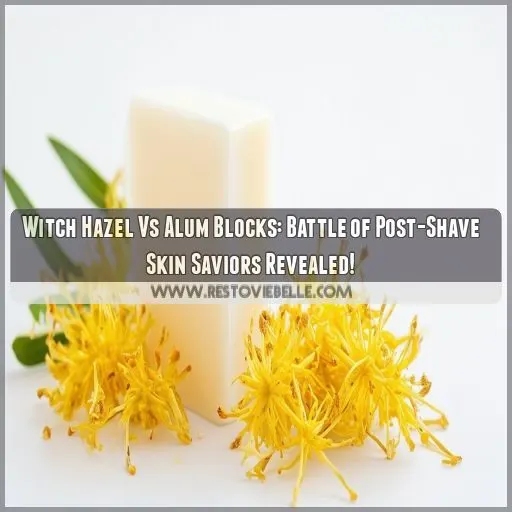
If you’re among them, you’ve probably wondered about witch hazel vs alum blocks or styptic pencils.
These post-shave saviors can be your skin’s best friends, but which one reigns supreme?
We’ll break down the differences between these remedies, exploring their unique properties and effectiveness.
You’ll discover how each works to soothe your skin, stop bleeding, and prevent irritation.
Get ready to transform your shaving routine and say goodbye to razor burn!
Table Of Contents
- Key Takeaways
- Witch Hazel, Alum Blocks, and Styptic Pencils: Key Differences
- Historical Uses of Witch Hazel in Skincare
- Alum Blocks: Ancient Mineral for Modern Shaving
- Styptic Pencils: Quick Fix for Shaving Nicks
- Witch Hazel: Nature’s Soothing Astringent for Shavers
- Comparing Effectiveness: Bleeding Control and Skin Benefits
- Incorporating Multiple Products in Shaving Routines
- Natural Vs. Synthetic: Choosing the Right Option
- Expert Recommendations and User Experiences
- Frequently Asked Questions (FAQs)
- What is the difference between alum block and styptic pencil?
- Is witch hazel a styptic?
- What is an alternative to alum block?
- Does witch hazel stop bleeding from shaving?
- Can witch hazel be used as a natural sunburn remedy?
- Are there any potential allergic reactions to alum blocks?
- How long does a typical styptic pencil last?
- Can these products be used on other parts of the body?
- Are there any environmental concerns with producing these products?
- Conclusion
Key Takeaways
- You’ve got options for soothing post-shave skin: Witch hazel for its anti-inflammatory properties, alum blocks to tighten pores and stop bleeding, or styptic pencils to quickly stem any nicks and cuts.
- Each remedy has its unique superpowers: witch hazel is nature’s comforting friend, alum blocks are like a gentle gym workout for your skin, and styptic pencils are the first responders for shaving accidents.
- These products have been around for ages: from Colonial America to Ancient Egypt, people have relied on these natural wonders for skincare and more.
- Whether you’re dealing with oily skin, sensitive patches, or razor burn, combining these remedies can create a comprehensive post-shave routine that tackles bleeding, irritation, and skin health.
Witch Hazel, Alum Blocks, and Styptic Pencils: Key Differences
You’ve probably encountered witch hazel, alum blocks, and styptic pencils in your shaving adventures, but do you know how they differ? Let’s unpack the unique properties of these post-shave heroes and see how they stack up in the battle against nicks, irritation, and other shaving woes.
Chemical Composition and Active Ingredients
You’ll find witch hazel‘s tannic acid, alum’s potassium aluminum sulfate, and styptic pencils’ aluminum sulfate all pack a powerful punch for your post-shave routine.
Primary Uses in Shaving and Skincare
You’ll find these post-shave heroes have distinct roles in your skincare arsenal. Here’s what they’re primarily used for:
- Witch hazel: Soothing inflammation
- Alum blocks: Tightening pores
- Styptic pencils: Stopping bleeding
- All three: Fighting bacteria
Application Methods and Techniques
You’ll apply each differently: Splash witch hazel, glide alum block, dab styptic pencil. It’s like choosing the right tool for your skin’s job!
Effectiveness in Stopping Bleeding
You’ve got options when it comes to stopping bleeding. Let’s compare the effectiveness of witch hazel, alum blocks, and styptic pencils.
- Styptic pencils: The bleeding control champs
- Alum blocks: Strong contenders with bonus benefits
- Witch hazel: Gentle but slower-acting
Skin Tightening and Astringent Properties
While alum and styptic pencils quickly tighten pores, witch hazel’s gentler astringent properties offer a soothing post-shave experience. Your skin’ll thank you!
Potential Side Effects and Skin Reactions
While these products tighten pores, they’re not without risks. You might experience redness, dryness, or irritation if you’re sensitive. Let’s dive deeper!
Historical Uses of Witch Hazel in Skincare
You might be surprised to learn that witch hazel’s been a skincare superstar for centuries! Native Americans were the first to discover its magical properties, using this natural wonder to treat everything from cuts to inflammation. When Colonial America rolled around, settlers quickly caught on to the herb’s healing powers. It’s like they’d stumbled upon nature’s very own first aid kit!
Fast forward to today, and witch hazel’s still working its charm as a skin toner and antiseptic. It’s the Swiss Army knife of skincare – tackling acne, soothing sunburns, and even shrinking pores. Talk about a multi-tasker! Whether you’re dealing with post-shave irritation or just looking for a natural pre-shave treatment, this timeless herbal remedy has got your back. So next time you reach for that bottle, remember – you’re tapping into centuries of skincare wisdom!
Alum Blocks: Ancient Mineral for Modern Shaving
You might think alum blocks are just another trendy grooming product, but they’ve actually been around for thousands of years. These ancient minerals have stood the test of time, offering modern shavers a natural way to soothe and protect their skin after taking a razor to it.
Origins and Traditional Applications
You might think alum blocks are a modern invention, but they’ve got quite the backstory! Let’s take a trip down memory lane:
- Ancient Egyptians used alum for mummification and as a natural deodorant.
- Greek philosophers praised alum’s healing properties for wounds and skin irritations.
- In medieval times, alum was worth its weight in gold as a fabric dye fixer.
These ancient uses paved the way for alum’s shaving superstar status today!
Chemical Structure of Potassium Alum
You’ve heard of alum blocks, but what’s the science behind them? Let’s take a closer look at the chemical structure of potassium alum, the star ingredient in these shaving saviors.
Benefits for Post-shave Skin Care
Now that you’ve got the lowdown on potassium alum, let’s take a closer look at the post-shave perks. Your skin’s about to thank you for this ancient mineral’s modern magic!
Antibacterial and Antiperspirant Properties
Alum blocks aren’t just post-shave heroes—they’re your skin’s secret weapon against bacteria and sweat. Think of them as nature’s deodorant, keeping you fresh and confident all day long.
Storage and Maintenance of Alum Blocks
You’ve conquered the shave, now let’s keep your alum block in tip-top shape! Proper storage helps this ancient mineral stay ready for your modern grooming needs. Here’s the scoop:
Styptic Pencils: Quick Fix for Shaving Nicks
When you’re in a rush and nick yourself shaving, a styptic pencil can be your best friend. These handy little tools are designed to quickly stop bleeding from small cuts, making them a popular choice for shavers who want a quick fix without the fuss.
Composition of Styptic Pencils
Ever wondered what’s in those magical styptic pencils? They’re not just any old pencils! These little lifesavers are packed with aluminum sulfate, a natural mineral compound.
Mechanism of Action for Stopping Bleeding
Ever wondered how styptic pencils work their magic on those pesky shaving nicks? It’s all about astringent action and blood coagulation. Here’s the lowdown:
- They constrict blood vessels faster than you can say "ouch!"
- The aluminum sulfate in styptic pencils triggers rapid clotting
- Your body’s natural healing process gets a turbo boost
Proper Application Techniques
Now that you know how styptic pencils work, let’s get into using them like a pro. Trust me, it’s easier than tying your shoelaces!
Potential Stinging Sensation and Discomfort
After applying a styptic pencil, you might feel a zing! It’s not uncommon to experience a brief stinging sensation, especially if you’ve nicked yourself. Don’t worry, though—it’s temporary.
Portability and Convenience Factors
You’ll love the travel-friendly nature of styptic pencils. These pocket-sized lifesavers are perfect for on-the-go touch-ups. Here’s why they’re a shaver’s best friend:
- Compact as a lipstick
- Fits in any dopp kit
- TSA-approved for carry-on
Witch Hazel: Nature’s Soothing Astringent for Shavers
You’ve probably heard of witch hazel, but did you know it’s a natural powerhouse for post-shave skincare? This botanical extract offers a gentle yet effective solution for soothing irritation, tightening pores, and calming your skin after a close shave.
Botanical Source and Extraction Process
While styptic pencils stop bleeding, witch hazel’s a different beast. It’s extracted from the witch hazel shrub through distillation, giving you a natural astringent packed with plant goodness.
Anti-inflammatory and Antioxidant Properties
Witch hazel’s not just a pretty face in your medicine cabinet. It’s a powerhouse of anti-inflammatory and antioxidant goodness, ready to soothe your post-shave skin like a gentle hug.
Toning and Pore-tightening Effects
Witch hazel’s toning prowess is like a gentle gym workout for your skin. It tightens pores, leaving your face feeling fresh and firm. Here’s how it benefits your skin:
- Reduces pore visibility
- Improves skin texture
- Balances oil production
Compatibility With Sensitive Skin Types
If you’ve got sensitive skin, witch hazel might be your new best friend. It’s gentler than alum blocks, soothing irritation without the sting. Your face will thank you!
Various Forms: Liquid, Gel, and Wipes
You’ll love witch hazel’s versatility! It comes in liquid, gel, and wipe forms, each offering unique benefits. Choose the one that fits your routine like a glove.
Comparing Effectiveness: Bleeding Control and Skin Benefits
You’ve got your witch hazel and alum block, but which one’s the real post-shave superhero? Let’s compare these skin-saving champions to see how they stack up in stopping bleeds, soothing irritation, and keeping your face happy after a close shave.
Speed of Blood Clotting for Each Product
For clotting speed, styptic pencils are the fastest, followed by alum blocks. Witch hazel’s a bit slower, but it’s gentler on your skin. Choose wisely!
Duration of Astringent Effects on Skin
Ever wonder how long your post-shave relief lasts? Alum blocks keep your skin tight for hours, while witch hazel’s effects fade faster. It’s like choosing between a long-lasting hug or a quick pat!
Soothing Properties and Irritation Reduction
You’re in for a treat! Both witch hazel and alum blocks are amazing for soothing your skin. They’re like a cool breeze on a hot day.
Long-term Skin Health Improvements
You’re in it for the long haul, right? Both witch hazel and alum blocks can be your skin’s BFFs, offering more than just quick fixes. Let’s get into it!
Compatibility With Different Skin Types
You’re unique, and so is your skin! Whether you’re battling oily patches or soothing sensitive areas, witch hazel and alum blocks have got your back. Let’s get started!
Incorporating Multiple Products in Shaving Routines
You don’t have to choose just one post-shave product when you can use several. By combining witch hazel, alum blocks, and styptic pencils in your routine, you’ll create a smart approach that tackles bleeding, irritation, and skin health all at once.
Combining Witch Hazel With Alum Blocks
You can double up on post-shave benefits by using both witch hazel and alum blocks. Apply the alum first to tighten pores, then follow with witch hazel to soothe and refresh. It’s like a one-two punch for your skin!
Using Styptic Pencils as Spot Treatments
When you nick yourself shaving, reach for a styptic pencil. These handy spot treatments quickly stop bleeding, giving you pinpoint control. Just dab the tip on cuts—it might sting a bit, but it’s a real skin-saver!
Creating a Comprehensive Post-shave Regimen
After mastering spot treatments, it’s time to level up your post-shave game. Let’s create a skincare symphony that’ll have your face singing! We’ll blend witch hazel, alum blocks, and styptic pencils into a harmonious routine.
Addressing Specific Skin Concerns Effectively
Now that you’ve got your post-shave routine down pat, let’s tackle those pesky skin concerns head-on. Whether you’re battling razor burn, ingrown hairs, or sensitive skin, we’ve got you covered. Here are three game-changing solutions:
- Alum for acne-prone skin
- Witch hazel for redness
- Styptic pencil for weepers
Natural Vs. Synthetic: Choosing the Right Option
So, you’re thinking about post-shave care, right? You’ve got a choice between natural stuff and the synthetic stuff. Let’s talk about witch hazel and alum blocks, looking at how they impact the environment, if they’re good for sensitive skin, how much they cost, and how easy they’re to find. This will help you decide what’s best for your skincare routine.
Environmental Impact of Each Product
When choosing your post-shave savior, consider the environmental impact. Let’s break down the eco-friendliness of witch hazel and alum blocks:
| Product | Sustainability | Biodegradability |
|---|---|---|
| Witch Hazel | Renewable resource | Easily biodegradable |
| Alum Block | Mineral-based | Slow to degrade |
You’ll be doing Mother Nature a solid with either choice!
Allergenic Potential and Skin Sensitivities
You’re not alone if you’ve got sensitive skin! While witch hazel’s natural origins might seem gentler, some folks still experience reactions. Alum blocks, though synthetic, are generally well-tolerated. It’s all about finding your skin’s perfect match!
Cost Comparison and Value for Money
While natural options like witch hazel might seem pricier, they often pack more bang for your buck. Let’s break down the cost-benefit analysis:
- Long-lasting alum blocks offer great value
- Witch hazel’s versatility justifies its price tag
- Synthetic options: cheaper but less effective
Availability and Ease of Purchase
You’ll find these post-shave heroes easily online and in stores. Let’s compare their availability and price range:
| Product | Availability | Price Range |
|---|---|---|
| Witch Hazel | Widespread | $5-$15 |
| Alum Blocks | Moderate | $7-$20 |
| Styptic Pencils | Common | $3-$10 |
| Synthetic Options | Varied | $5-$25 |
| Natural Alternatives | Limited | $10-$30 |
Expert Recommendations and User Experiences
Post-shave care is a topic where experts and experienced users have a ton of advice to share. Let’s explore what dermatologists, barbers, and seasoned shavers say about witch hazel, alum blocks, and styptic pencils to help you make the best choice for your skin.
Dermatologist Insights on Product Efficacy
You’re in for a treat! Dermatologists swear by alum’s efficacy in tightening pores and controlling minor bleeding. While some docs praise witch hazel’s gentle nature, others caution about potential irritation. Remember, your skin’s unique, so what works for your buddy mightn’t be your cup of tea.
Barber Preferences for Professional Use
Ever wondered what the pros prefer? Barbers often go for alum blocks and styptic pencils for their clients. Here’s why they’re fan favorites:
- Quick bleeding control
- Minimal skin irritation
- Long-lasting effectiveness
- Easy to apply and clean up
These tools are like a barber’s secret weapons against razor burn!
Tips for Maximizing Benefits of Each Product
Ready to level up your shaving game? Here’s the inside scoop on maximizing those post-shave saviors. Whether you’re Team Witch Hazel, Alum Block, or Styptic Pencil, we’ve got you covered. Check out this handy guide to become a master of your post-shave routine:
| Product | Pro Tip | Emotional Benefit |
|---|---|---|
| Witch Hazel | Chill it for extra soothing | Cooling relief |
| Alum Block | Pat, don’t rub | Gentle confidence |
| Styptic Pencil | Less is more | Quick fix triumph |
| Combo Method | Layer products wisely | Skincare mastery |
| DIY Solution | Customize your blend | Creative control |
Frequently Asked Questions (FAQs)
What is the difference between alum block and styptic pencil?
You’ll find alum blocks and styptic pencils are like shaving’s dynamic duo. Alum blocks soothe your whole face, while styptic pencils are your go-to for those pesky nicks. They’re both astringents, but with different superpowers!
Is witch hazel a styptic?
No, witch hazel isn’t a styptic. While it’s great for soothing skin, it won’t stop bleeding like styptics do. Think of witch hazel as your skin’s comforting friend, whereas styptics are more like your cut’s first responder.
What is an alternative to alum block?
Styptic pencils are a popular alternative to alum blocks. They’re made from the same compounds but in a compact, lipstick-sized form. You could also try witch hazel.
Does witch hazel stop bleeding from shaving?
Yep, witch hazel is a natural ingredient in many aftershaves. It’s known to stop bleeding from shaving cuts, soothe the skin, and reduce redness.
Can witch hazel be used as a natural sunburn remedy?
Did you know 40% of Americans will get sunburned this year? Witch hazel is a natural sunburn remedy. It’s rich in tannins, which reduce inflammation. Use pure witch hazel on a cotton round or washcloth, gently applying to sunburned skin.
Are there any potential allergic reactions to alum blocks?
Yes, there’s a risk of allergic reaction to alum blocks. If you experience excess irritation, stop using alum blocks and consult a doctor. Some studies suggest that aluminium in deodorants may increase the risk of breast cancer.
How long does a typical styptic pencil last?
Sourcing a styptic pencil that suits your needs is a breeze. With proper care, these pencils can last a long time—some folks claim theirs have lasted over two decades!
Can these products be used on other parts of the body?
Alum blocks can be used all over the face and body. Styptic pencils are designed for spot treatment, but can be used on cuts elsewhere on the body. Witch hazel can be used all over the face.
Are there any environmental concerns with producing these products?
Traditional, real shaving is more eco-friendly. T.N. Dickinson’s Witch Hazel is committed to sustainable practices and sources from USDA-certified organic forestlands. They also use renewable energy sources and sell wood chips as landscaping mulch.
Conclusion
You’re now armed with the knowledge to decide between witch hazel, alum blocks, or styptic pencils for your post-shave woes.
Each option offers unique benefits, but the choice ultimately depends on your specific needs and preferences.
Happy shaving!

